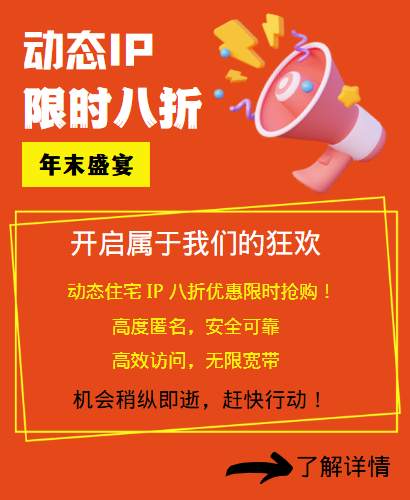HTTP proxy IP plays a vital role in scenarios such as web crawlers, data crawling, and online marketing. However, not all proxy IPs are reliable and effective. Invalid proxy IPs not only waste time and resources, but may also bring security risks. Therefore, it is particularly important to learn how to detect the effectiveness of HTTP proxy IP. This article will explore this topic in depth and provide you with a comprehensive and practical detection method from multiple dimensions.

I. Basic detection: connectivity and response speed
1.1 Connectivity test
Connectivity is the first step in detecting the effectiveness of HTTP proxy IP. You can determine its connectivity by sending HTTP requests to the proxy server and observing whether the connection can be successfully established. Commonly used tools include curl, wget, or Python's requests library.
curl -x http://<proxy\_ip>:<port> http://www.example.com
If the request successfully returns the webpage content, it means that the proxy IP connectivity is good; if it returns an error message, such as "Could not resolve host" or "Connection refused", it means that the proxy IP may be invalid or has been blocked.
1.2 Response speed test
Response speed is another important indicator for evaluating the quality of proxy IP. Use the ping command or a dedicated network speed test tool to measure the round-trip time (RTT) from the client to the proxy server and then to the target website. Shorter RTT means faster response speed and is more suitable for application scenarios that require real-time interaction.
ping -c 4 <proxy_ip>
II. Anonymity detection: the ability to hide the real IP
2.1 HTTP header check
When accessing a website through a proxy, check the X-Forwarded-For, Via and other fields in the HTTP response header to confirm whether they leak your real IP address. If the proxy server fails to properly hide this information, the anonymity of the proxy is insufficient.
2.2 Verify using online tools
Use online services such as "Whois my IP" or "What is my IP address" to access through the proxy and check whether the displayed IP address is the IP of the proxy server. This is an intuitive way to verify the anonymity of the proxy.
III. Stability and persistence test
3.1 Long-term running test
Set up a script or program to continuously send requests through the proxy IP and observe the stability and availability of the proxy over a period of time. Proxy IPs that work stably for a long time are more trustworthy.
3.2 Load test
Simulate high-concurrency access scenarios and test the performance of the proxy IP under high load. If the proxy can maintain a stable response speed and success rate, it means that it has strong processing capabilities and is suitable for large-scale data capture or web crawler tasks.
IV. Security Assessment: Guarding Against Malicious Proxies
4.1 Malware Scanning
Use anti-virus software or online security scanning tools to check whether the proxy IP is associated with known malware or phishing websites. Avoid using proxies with security risks to protect your data and privacy.
4.2 Blacklist Check
Check whether the proxy IP is on the public blacklist. Blacklisted proxy IPs are often involved in spam sending, network attacks, etc., which should be avoided.
V. Comprehensive Assessment and Optimization
5.1 Comprehensive Scoring System
Combining the above test results, score each proxy IP and establish a comprehensive assessment system. Set score thresholds according to business needs to screen out high-quality proxy IP pools.
5.2 Regular Maintenance and Updates
The effectiveness of proxy IPs is not static, so it is necessary to re-test regularly to eliminate expired or degraded proxies. At the same time, as the network environment changes, adjust the detection strategy in a timely manner to ensure the continued effectiveness of the proxy IP pool.
Conclusion
Detecting the effectiveness of HTTP proxy IP is a systematic project, which requires comprehensive consideration from multiple dimensions such as connectivity, anonymity, stability, persistence and security. By implementing the above detection methods, you can effectively screen out high-quality proxy IPs and improve the execution efficiency and security of network tasks. Remember, continuous monitoring and updating are the key to keeping the proxy IP pool active. I hope this article can provide valuable reference for your proxy IP detection journey.
Related Recommendations
- How to realize e-commerce collection through residential agent IP?
- Analyzing dynamic IP address allocation mechanism: principles and implementation
- Global business acceleration: Exploring the value of proxy IP in enterprise applications
- Breakthroughs in geographical restrictions for cross-border e-commerce: Practical strategies for dynamic residential IP
- Application and advantages of overseas agent IP in various business scenarios
- Metaverse Nuggets: Proxy IP helps data collection in the virtual world
- How can the residential agent network help crawl Amazon?
- How to automatically obtain an ip address from an agent?
- How to operate a U.S. TikTok store with U.S. residential IP?
- What matters should companies pay attention to when using residential agent IP?

